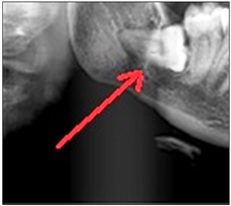Phenotypic heterogeneity of impacted third molar tooth: family case study
Abstract
Tooth impaction is a pathological condition where a tooth fails to attain its normal functional position. The present study aims to highlight the phenotypic heterogeneity of impacted third molars in a Caucasian family, to investigate the characteristics of the dental phenotype, to evidence the diversity of dental phenotype, and to identify the inheritance mode of the condition. Detailed anamnesis, clinical examination, complementary tests (panoramic radiographs), family study and pedigree analysis. Phenotypic characteristics of impacted third molar tooth in our family case report was: Severe horizontal impaction of the mandibular right third molar, Angular impaction of the maxillary right third molar and angular impaction of the maxillary left third molar, Angular impaction of the mandibular left third molar and partial eruption of the maxillary right third molar, Horizontal impaction of the mandibular left third molar and Angular impaction of the mandibular left third molar. The inheritance mode of the impacted third molar tooth in the family case report was: from mother to both daughters’ transmission, from mother to both sons’ transmission, and from mother to daughter transmission. Family study and pedigree analysis are very important for illustrate the genetic basis of impacted teeth.
Downloads
References
Santosh P. Impacted Mandibular Third Molars: Review of Literature and a Proposal of a Combined Clinical and Radiological Classification. Ann Med Health Sci Res. 2015;5(4):229-234. doi: http://dx.doi.org/10.4103/2141-9248.160177.
Janakiraman EN, Alexander M, Sanjay P. Prospective analysis of frequency and contributing factors of nerve injuries following third-molar surgery. J Craniofac Surg. 2010;21(3):784-786. doi: https://doi.org/10.1097/SCS.0b013e3181d7f29a.
Shapira Y, Kuftinec MM. Tooth transpositions--a review of the literature and treatment considerations. Angle Orthod. 1989 Winter; 59(4):271-276. doi: 10. 1043/ 0003-3219(1989)059<0271:TTAROT>2.0.CO;2.
Sarica I, Derindag G, Kurtuldu E, Naralan ME, Caglayan F. A retrospective study: Do all impacted teeth cause pathology? Niger J Clin Pract. 2019; 22(4): 527-533. doi: http://www.njcponline.com/text.asp?2019/22/4/527/255936.
Khan NB, Chohan AN, Al Mograbi B, Al Deyab S, Zahid T, Al Moutairi M. Eruption Time of Permanent First Molars and Incisors Among a Sample of Saudi Male School children. Saudi Dent J. 2006;18:18-24.
Juodzbalys G, Daugela P. Mandibular third molar impaction: review of literature and a proposal of a classification. J Oral Maxillofac Res. 2013;4(2):e1. doi: https://dx.doi.org/10.5037%2Fjomr.2013.4201.
Kruger E, Thomson WM, Konthasinghe P. Third molar outcomes from age 18 to 26: findings from a population-based New Zealand longitudinal study. Oral Surg Oral Med Oral Pathol Oral Radiol Endod. 2001;92(2):150-155. doi: https://doi.org/10.1067/moe.2001.115461
Yuasa H, Sugiura M. Clinical postoperative findings after removal of impacted mandibular third molars: prediction of postoperative facial swelling and pain based on preoperative variables.BrJOralMaxillofac Surg 2004;42(3):209-214.doi: https://doi.org/10.1016/j.bjoms.2004.02.005
Zengin AZ, Sumer AP, Karaarslan E. Impacted primary tooth and tooth agenesis: a case report of monozygotic twins. Eur J Dent. 2008;2(4):299-302.
Lytle JJ. Etiology and indications for the management of impacted teeth. Northwest Dent. 1995; 74 (6):23-32.
Andrade I Jr, Paschoal MA2, Santos TO3. Spontaneous Eruption of Severely Impacted teeth: The Report of Two Cases. J Clin Exp Dent. 2019;11(5): e491-e495. doi: https://dx.doi.org/10.4317%2Fjced.55514. eCollection 2019 May.
Oenning AC, Neves FS, Alencar PN, Prado RF, Groppo FC, Haiter-Neto F. External root resorption of the second molar associated with third molar impaction: comparison of panoramic radiography and cone beam computed tomography. J Oral Maxillofac Surg. 2014;72 (8): 1444-1455. doi: https://doi.org/10.1016/j.joms.2014.03.023. Epub 2014 Mar 31.
Kassawara AB, Tagliaferro EP, Cortelazzi KL, Ambrosano GM, Assaf AV, Meneghim Mde C, et al. Epidemiological assessment of predictors of caries increment in 7-10- year-olds: a 2-year cohort study. J Appl Oral Sci. 2010;18(2):116-20. doi: http://dx.doi.org/10.1590/S1678-77572010000200004
Farah CS1, Harmon DM. Tongue piercing: case report and review of current practice. Aust Dent J. 1998; 43(6):387-389. doi: https://doi.org/10.1111/j.1834-7819.1998.tb06095.x.
Thilander B, Jakobsson SO. Local factors in impaction of maxillary canines. Acta Odontol Scand. 1968;26 (2):145-168. doi: https://doi.org/10.3109/00016356809004587.
Adaki SR, Yashodadevi BK, Sujatha S, Santana N, Rakesh N, Adaki R. Incidence of cystic changes in impacted lower third molar. Indian J Dent Res. 2013;24(2):183-187. doi: http://www.ijdr.in/text.asp?2013/24/2/183/116674.
Noorollahian S, Shirban F. Chair time saving method for treatment of an impacted maxillary central incisor with 15-month follow-up. Dent Res J.2018; 15(2):150-154.
Almendros-Marqués N, Berini-Aytés L, Gay-Escoda C. Influence of lower third molar position on the incidence of preoperative complications. Oral Surg Oral Med Oral Pathol Oral Radiol Endod. 2006;102(6):725-732. Epub 2006 Jul 14.doi: https://doi.org/10.1016/j.tripleo.2006.01.006.
Richardson G, Russell KA. A review of impacted permanent maxillary cuspids--diagnosis and prevention. J Can Dent Assoc. 2000;66(9):497-501.
Bondemark L, Tsiopa J. Prevalence of ectopic eruption, impaction, retention and agenesis of the permanent second molar. Angle Orthod. 2007; 77 (5): 773-778. doi: https://doi.org/10.2319/072506-306.1.



 OAI - Open Archives Initiative
OAI - Open Archives Initiative


